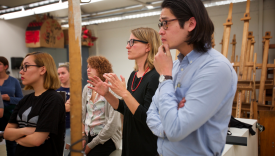European Studies 241 - Italian Renaissance
(Offered as ARHA 241, ARCH 241, and EUST 241) Michelangelo, a defining genius of the Italian Renaissance, emerged from a rich cultural environment that forever changed how we think of art. Artists of the Renaissance developed an original visual language from the legacy of the ancient world, while also examining nature, their environment, and encounters with other worlds to the East and West. Their art revealed a profound engagement with philosophical attitudes toward the body and the spirit, as well as with ideals of pious devotion and civic virtue. Those concepts changed radically over the period of the Renaissance, however. Artists developed the rhetoric of genius and artistic struggle by vaunting an artist’s godlike role, owing to his imaginative creation of art and his ability to mimic reality illusionistically, yet they also questioned a human’s place in the cosmos. We will analyze in depth the visual language of painting, sculpture, and architecture created for merchants, monks, princes and popes in the urban centers of Florence, Rome and Venice from the 14th through the 16th centuries, and examine the virtuosic processes artists used to achieve their goals.
Rather than taking the form of a survey, this course, based on lectures but regularly incorporating discussion, will analyze selected works and contemporary attitudes toward the visual through study of the art and its primary sources.
Learning goals:
- Gain confidence in the art of close looking to gain visual understanding;
- Achieve an understanding about how art and its culture are intertwined;
- Develop the critical skills to analyze points of view from a historical period other than our own;
- Learn collaboratively with classmates;
- Develop and argue an original thesis about a single work of art in a research paper.
Meets twice a week, 1 hour and 20 minutes.
One course in ARHA, FAMS, or ARCH recommended.
Uncapped.
Presence of the instructor:
- The students present on campus will meet together in a classroom. Remote students will join in the synchronous class. Remote students in distant time zones will have the option of a second class at an agreed-upon time, or recorded lectures and a weekly tutorial with the professor.
- The professor will lecture and lead discussion remotely (synchronous).
- There will be asynchronous class preparation.
- Smaller weekly discussion groups, divided into different time zones for off-campus students (synchronous), and posting on discussion boards (asynchronous).
- Professor will hold in-person office hours if possible.
Spring semester. Professor Courtright.


